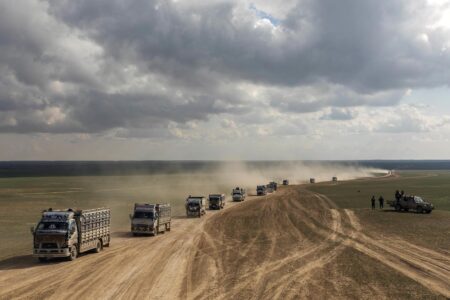
The Islamic State terrorist group is a problem of yesterday, today and tomorrow
More than three years after its military defeat in Iraq and Syria, ISIS is a downgraded threat thanks to the collective efforts of the U.S.-led global coalition that coalesced to defeat it along with Iraqi and Syrian partners.
While the extremist group’s capacity has been drastically reduced and millions of people have returned home, ISIS has managed to continue attacks year after year despite no longer holding territory.
Meanwhile, some of the most difficult human legacies — the challenges facing the people the ISIS conflict left behind — are still with us, with no end in sight.
While the number of people still affected by the conflict undoubtedly reaches into the millions, the nuances of each group are important when it comes to understanding their status and formulating a response to address their problems and the lessons learned to inform future action.
One of the thorniest problems ISIS has left behind is the thousands of displaced persons affiliated or perceived to be affiliated with ISIS, who are languishing in camps or outside their areas of origin in Iraq and Syria.
The human legacies of the ISIS conflict range from people who have no affiliation from the perspective of the authorities and the community (important distinctions) to others having perceived affiliation, whether they are an individual or an entire family or even tribe or sect, to others with actual affiliation, who are families of actual ISIS members. This piece will focus on displaced persons, not ISIS members and detainees.
There are many people that currently treat ISIS as if is it’s yesterday’s problem. That in and of itself is a problem.
Some see what remains of the ISIS conflict as a security issue that the Iraqi Security Forces and the Syrian Democratic Forces (SDF) can handle.
Others think there are more important priorities, like Russia’s war in Ukraine or great power competition.
But ISIS is the problem of yesterday, today and tomorrow. We have a multi-generational challenge on our hands — not just when you look back on the history of extremism in this region over the past 30 years, but also looking forward at how the next 10 to 20 years might unfold.
As General Kenneth McKenzie, former commander of the U.S. Central Command, put it to a USIP audience in 2020:“The enduring defeat of ISIS has got to incorporate a way forward for the displaced persons and all the people that are at risk across the theater; if not, we are actually never really going to defeat ISIS and the problem is going to come back.” In fact, some of these issues are already present in Iraq and Syria: Thousands of fighters are still at large, more are in prison, while their family members are vulnerable or may present vulnerability, if unaddressed.
When it comes to displacement stemming from the ISIS conflict, there is no better encapsulation of the challenges we face than al-Hol.
The al-Hol camp in northeast Syria is one of the most complex manifestations of the human legacies of ISIS, with about 57,000 people from 60 countries currently living there, mostly women and children.
Between al-Hol and the nearby Rozh camp, there are roughly 40,000 children (thousands are orphans) among this displaced population.
Analysts, government officials, NGO leaders and members of the community have a wide range of descriptions for al-Hol, calling it a “ticking time bomb,” the “Guantanamo of the Middle East,” an “ISIS Depot,” “ISIS University,” or “the Caliphate,” among other names. Some use these references in an attempt to raise the urgency of the need to address the crisis, while others use it to state that the camp’s residents are dangerous.
These terms are de-humanizing and work against the very objective of trying to return and reintegrate these people back into society. How could we expect countries and communities to take these people back when they are described with these kinds of names?
Media outlets calling all of them “ISIS families” and sharing videos that only show a partial view that could be demonizing and counter-productive does not help. We need to come together to adopt relevant terms and descriptions that at the very least prevent harm and help with addressing the challenge.
Security both inside and around the camp is challenging. Last year, there were more than two murders per week in the camp, leading to decreased access for humanitarian actors.
Current and former residents of al-Hol report that they are afraid to sleep because they could be killed while sleeping; Iraqis seem to be targeted the most.
News of sexual abuse is also spreading, which could cause tensions with communities of origin for these people. And reports of smuggling into and out of the camp deepens concerns about corruption and gaps in security throughout the camp.
Meanwhile, the camp has become a target for ISIS fighters that still operate in northeast Syria.
Earlier this year, ISIS orchestrated an assault on the al-Sinaa prison where a number of their fellow militants were detained.
The ensuing fight left hundreds dead and helped an undetermined number of prisoners escape, demonstrating ISIS efforts to resurge and free its members from detainment.
In addition to the violence, the re-establishment of al-Hisba, ISIS’ police force, in al-Hol has contributed to an environment of fear and indoctrination.
There are different elements to the ISIS conflict: the ideology, the organization that operationalized the ideology and the enabling environment, which includes the people and circumstances that facilitated the rapid rise of ISIS.
The enabling environment is what gives scale to the problem as well as the solution.
Source: USIP





